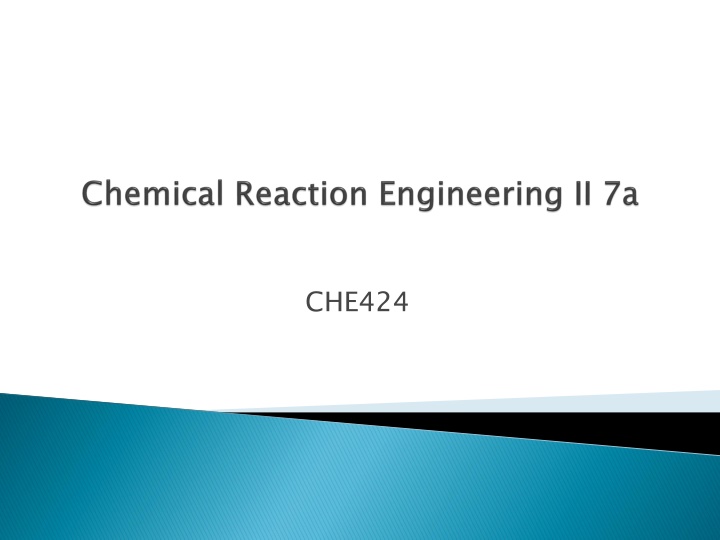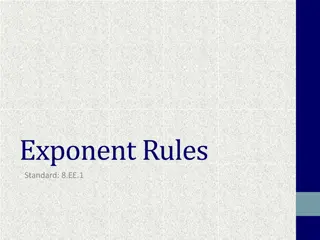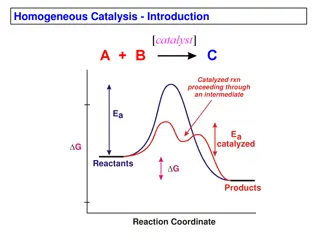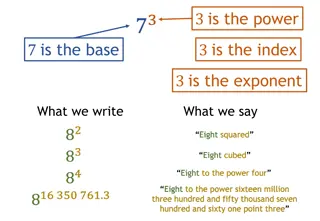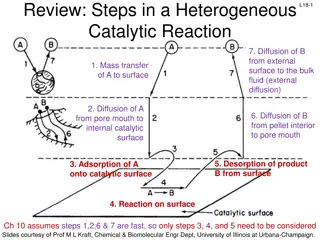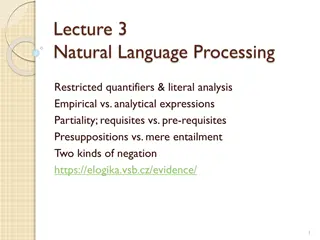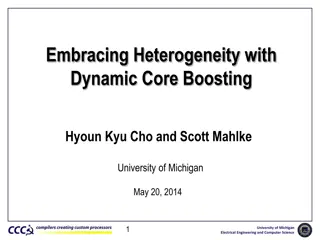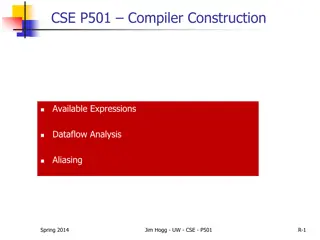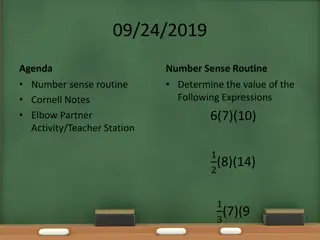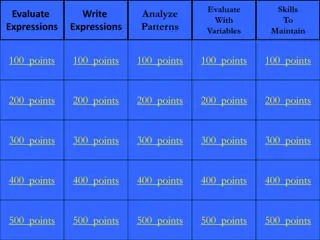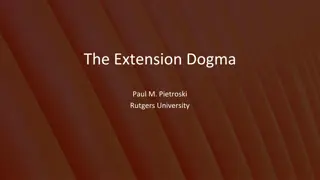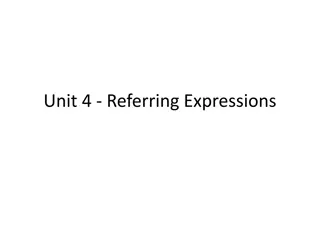Rate Expressions in Heterogeneous Systems
In heterogeneous systems, the rate expression involves mass transfer terms alongside chemical kinetics terms due to the presence of multiple phases. Different types of heterogeneous systems have varying mass transfer complexities, making a general rate expression challenging to define. Examples such as the burning of carbon particles and aerobic fermentation illustrate the multiple rate steps involved. Combining and simplifying these steps can lead to an overall rate expression, with considerations for linear and nonlinear concentration dependencies.
Download Presentation

Please find below an Image/Link to download the presentation.
The content on the website is provided AS IS for your information and personal use only. It may not be sold, licensed, or shared on other websites without obtaining consent from the author.If you encounter any issues during the download, it is possible that the publisher has removed the file from their server.
You are allowed to download the files provided on this website for personal or commercial use, subject to the condition that they are used lawfully. All files are the property of their respective owners.
The content on the website is provided AS IS for your information and personal use only. It may not be sold, licensed, or shared on other websites without obtaining consent from the author.
E N D
Presentation Transcript
For heterogeneous systems, there are two complicating accounted for rather than in homogeneous systems. The complication and contacting patterns for two phase systems. Since more than one phase is present, the movement of material from phase to phase must be considered in the rate equation. factors that should be of the rate expression complication secondly the of the
Thus the rate expression in general will incorporate mass transfer terms in addition to the usual chemical kinetics term. These mass transfer terms are different in type and numbers in the different kinds of heterogeneous systems; therefore no single rate expression has general application. For example; the burning of carbon particle in air, how many rate steps are involved? C + O2 CO2
The figure shows us that there are two steps in series; mass transfer of O2 to the surface followed by reaction at the surface of particle
In aerobic fermentation, how many rate steps are involved when air bubbles through a tank of liquid which contains dispersed microbes and is taken up by the microbes to produce product. Figure 2: Fermentation reaction
There are about 7 possible resistance steps, but only one involving the reaction. how many you choose to consider depends on you and the situation. To get an overall expression, write the individual rate steps on the same basis (unit surface of burning particle, unit volume of fermenter, unit volume of cell, etc)
Or Or Now put all the mass transfer and reaction steps into the same rate form and combine; Or
And if the steps are in series as in the previous examples; roverall =r1 = r2 = r3 if they are parallel; roveral = r1 +r2 Consider steps in series, in general if all steps are linear in concentration, then it is easy to combine them. But if any of the steps are nonlinear, then you will get a messy overall expression. You may try to bypass this nonlinear step in one of the various ways.
Approximating the rA versus CA curve by a first-order expression is probably the most useful procedure. Another point: in combining rates the concentration of materials at intermediate conditions are not known, these are the concentrations which are eliminated in combining rates. Overall rate for a linear process. Dilute A diffuses thru a stagnant liquid film onto a plane surface consisting of B, reacts there to produce R which diffuses back into the main stream.
Develop the overall expression for the liquid/solid reaction. A(l) + B(s) => R(l) which takes place on the flat surface.
By diffusion the flux of A to the surface is Reaction is first-order with respect to A, based on unit surface: At steady-state the flow rate to the surface is equal to the reaction rate at the surface (step in series) so rA 1 = rA 2 and from (1) and (2) (1) (2) (3)
Replacing (3) into (i) or (ii) and eliminating CA which cannot be measured, we get; This shows that 1/kl and 1/k are additive resistances. The addition of resistances to obtain an overall resistance is only possible when the rate is a linear function of the driving force and when the process occurs in series.
When we make just one change; the reaction is second order; Combining the reaction steps to eliminate CA as was done previously is not so simple now, it gives; Contacting patterns for two phases Contacting patterns for two phases
There are many ways that two phases can be contacted, and for each the design equation will be unique. When real flow deviates considerably from these, we can do one of two things: (i) we may develop models to mirror actual flow closely, or (ii) we may calculate performance with ideal patterns which "bracket" actual flow. Fortunately, most real reactors for heterogeneous systems can be satisfactorily approximated by one of the five ideal flow patterns of the Fig. below. Notable exceptions are the reactions which take place in fluidized beds. There special models must be developed.
In reactor design and scale-up, it is essential to select a flow model which reasonably represents our setup. When you pick a non-representative model and then do computer calculations to the nth degree of accuracy, you will be surprised when design and scale-up do not agree with the predictions. A simple reasonable model is much better than a precise and detailed model which does not represent the contacting. Often the choice of a good flow model and the knowledge of how the flow pattern changes with scale-up spells the difference between success and failure.
There are two broad classes of catalysts: those that operate at close to ambient temperature with biochemical systems, and the man-made catalysts that operate at high temperature. The biochemical catalysts, called enzymes, are found everywhere in the biochemical world and in living creatures, and without their action no life could exist at all. In addition, in our bodies hundreds of different enzymes and other catalysts are busy at work all the time, keeping us alive.
The man-made catalysts, mostly solids, usually aim to cause the high-temperature rupture or synthesis of materials. These reactions play an important role in many industrial processes, such as the production of methanol, sulphuric acid, ammonia, and various petrochemicals, polymers, paints, and plastics. It is estimated that well over 50% of all the chemical products produced today are made with the use of catalysts.
Consider petroleum. For example, since this consists of a mixture of many compounds, primarily hydrocarbons, its treatment under extreme conditions will cause a variety of changes to occur simultaneously, producing a spectrum of compounds, some desirable, others undesirable. Although a catalyst can easily speed the rate of reactions still when a variety of reactions are encountered, the most important characteristic of a catalyst is its selectivity By this we mean that it only changes the rates of certain reactions, often a single reaction, leaving the rest unaffected. Thus, in the presence of an appropriate catalyst, products containing predominantly the materials desired can be obtained from a given feed. selectivity.
Various theories have been proposed to explain the details of the way catalysts operate (read them). We simply assume that we have a catalyst available to promote a specific reaction and we wish to evaluate the kinetic behaviour of reactants in the presence of the catalyst and then use this information for design. Levenspiel Richardson s give 3 puts about 5 theories while
Levenspiel: (i) Surface kinetics happens at the interior or exterior surfaces of the particle (ii) Pore diffusion resistance what may cause the interior of pore to be starved of reactant (iii) Particle T temperature gradient within the particle (iv) Film T - between the outer surface of the particle and he main gas stream (v) Film Diffusion - resistance/conc. gradient across gas film Richardson s give 3 mechanisms: (i) Knudsen Diffusion when gas molecule diameter larger than pore diameter, collisions b tn. gas molecules become more preferred (ii) Molecular diffusion When gas molecules are smaller than pore diam. Collisions between molecules become more important. (iii) Surface Diffusion when a gas is adsorbed on inner surfaces of pore
Because of the great industrial importance of catalytic reactions, considerable effort has been spent in developing theories from which kinetic equations can rationally be developed. The most useful for our purposes supposes that the reaction takes place on an active site on the surface of the catalyst. Thus three steps are viewed to occur successively at the surface. Step attached Step adjacent Step frees In addition, all species of molecules, free reactants, and free products as well as site-attached reactants, intermediates, and products taking part in these three processes are assumed to be in equilibrium. Rate expressions derived from various postulated mechanisms are all of the form Step 1 1. . A A molecule attached to Step 2 2. . It It then adjacent site Step 3 3. . Products frees the molecule is is adsorbed to an then reacts site ( (dualsite Products are the site adsorbed onto site. . reacts either dualsite mechanism) are desorbed site. . onto the the surface surface and and is is an active active site either with with another another molecule molecule on on an an desorbed from from the the surface, surface, which which then then
For example, for a reaction; Occurring in inert carrier U, the rate expression when adsorption of A control is; When chemical reaction between adjacent site attached molecules of A and B control it is
Each detailed mechanism of reaction with its controlling factor has its corresponding rate equation involving anywhere from three to seven arbitrary constants, the K values. These complicated equations shall not be used but we shall use the contact time or space time instead. Pore surface First consider a single cylindrical pore of length L, with reactant A diffusing into the pore, and reacting on the surface by a first- order reaction taking place Pore diffusion surface kinetics diffusion resistance kinetics resistance combined combined with with
At the walls of the pore and the product diffusing out of the pore The rate is given by; The flow of materials into and out of any section of pore is shown in detail in Fig. 3. At steady state a material balance for reactant A for this elementary section gives; output - input + disappearance by reaction = 0
Or in eqn form; Rearranging it gives; Taking the limit as x approaches zero, In general, the interrelation between rate constants on different bases is
Thus for the cylindrical catalyst pore; In terms of volumetric units, we have Which is the frequently met linear differential equation whose general solution is; Where and M1 and M2 are constants
Here the boundary conditions have to be specified. For this system they are two; at the entrance of the pore, And at the end of pore; With the appropriate mathematical manipulation, Figure (18.4) is obtained; Where Hence the concentration of reactants within the pore is
